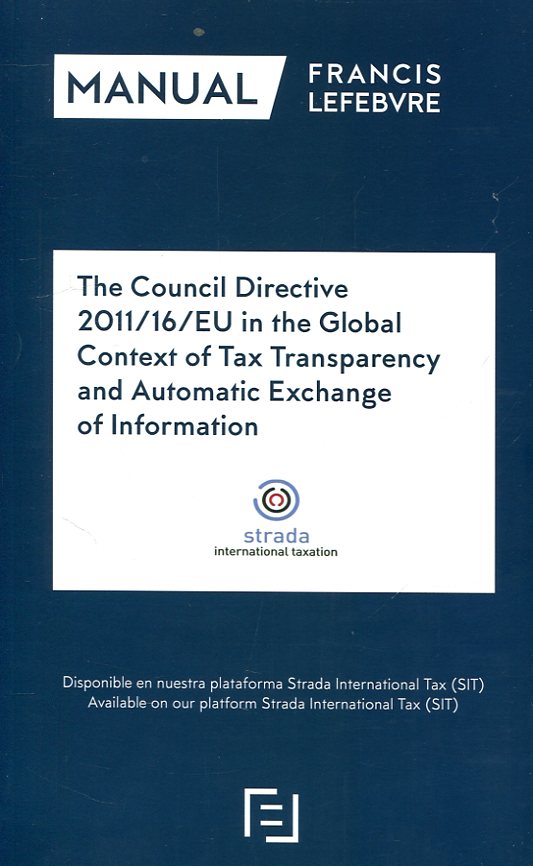The Council Directive 2011/16/EU in the Global Context of Tax Transparency and Automatic Exchange of Information
- ISBN: 9788417317454
- Editorial: Ediciones Lefebvre
- Fecha de la edición: 2018
- Lugar de la edición: Madrid. España
- Colección: Manual
- Encuadernación: Rústica
- Medidas: 22 cm
- Nº Pág.: 149
- Idiomas: Español

En el marco actual de la fiscalidad internacional, la cooperación administrativa y el intercambio de información son vistos como una de las pocas herramientas eficaces para luchar contra los fenómenos de la elusión fiscal, la evasión fiscal y la denominada planificación fiscal agresiva.
Prueba de ello es que en un período de tiempo muy corto, hemos pasado de la práctica inexistencia de intercambio transfronterizo de información con trascendencia tributaria al nacimiento y expansión de un nuevo estándar de intercambio automático de información tributaria, cuya aplicación más veloz e intensa se está produciendo en el territorio europeo.
En este contexto era necesario la publicación de esta obra, en la que se realiza un completo estudio de los mercados de capitales y regulaciones financieras del mundo de hoy.
Para ello, el presente manual realiza un análisis crítico y eminentemente práctico de la Directiva 2011/16/UE, que permite comparar este instrumento multilateral de cooperación administrativa con los auspiciados por otras organizaciones internacionales, mostrando sus principales fortalezas y debilidades. En él se abordan:
- los antecedentes y el contexto político y económico en el que nace la Directiva 2011/16/UE, y su interrelación con otros instrumentos internacionales de cooperación administrativa e intercambio de información;
- la finalidad de la Directiva, su fundamento jurídico, su alcance, las cuestiones de organización y los aspectos temporales;
- las diferentes formas de cooperación administrativa establecidas en la Directiva, con especial atención a las formas y procedimientos de intercambio de información (previa solicitud, espontáneo y automático);
- las condiciones y los límites de la cooperación administrativa, con especial énfasis en los límites del uso de la información provista;
- cada una de las reformas realizadas a la Directiva 2011/16 para potenciar e incrementar la eficacia del intercambio automático de información tributaria;
- las implicaciones del intercambio transfronterizo de información tributaria desde la óptica de los derechos y garantías de los obligados tributarios.
SUMARIO:
List of Abbreviations
Introduction
Chapter 1
The Directive on administrative cooperation in the field of taxation in the global context
I. Background of administrative cooperation and exchange of information in the EU: Directive 77/799/EEC and its shortcomings
II. The global economic and political context of the DAC
III. Interrelation between the DAC and other international instruments for exchange of information
Chapter 2
General Issues of the Directive 2011/16/EU
I. Purpose
II. Legal basis
III. Objective, subjective, temporal and spatial scope
IV. Organisation issues
Chapter 3
Exchange of information
I. Exchange of information upon request
II. Spontaneous exchange of information
III. Automatic exchange of information in the original version of the DAC
Chapter 4
Other forms of administrative cooperation
I. Presence in administrative offices and participation of foreign officials in administrative enquiries
II. Simultaneous controls
III. Administrative notifications
IV. Feedback
V. Sharing of best practices and experience
Chapter 5
Conditions of administrative cooperation, monitoring and evaluation activities, relations with third countries
I. Secrecy clause and use of the information received
II. Grounds for refusal of assistance
III. Most favoured nation clause
IV. Standard forms, computerised formats, channels of communication and language
V. Monitoring and evaluation of administrative cooperation
VI. Relations with third countries
Chapter 6
Evolucion of the DAC towards the global standard of automatic exchange of information
I. Automatic exchange of financial account information
A. Immediate antecedents: FATCA and OECD CRS/CAA
B. Purpose, scope and content
C. Timeline
D. Form of information transmission
E. Data protection
F. Similarities and differences between DAC 2 and OECD CRS
G. Critical evaluation
II. Automatic exchange of information on cross-border tax rulings and APAs
A. Immediate antecedents and purpose
B. Scope
C. Information subject to communication
D. Form of transmission
E. Timeline
F. Confidentiality and use of information
G. Position of taxpayers affected by the AEOI on cross-border tax rulings and APAs
H. Similarities and differences between DAC 3 and BEPS Action 5
I. Critical evaluation
III. Automatic exchange of information on country-by-country reports
A. Immediate antecedents and purpose
B. The obligation to prepare and file CbCRs
C. Automatic exchange of CbCRs: Scope, Format, Timeline and Limits
D. Towards public disclosure of CbCRs in the EU?
E. Similarities and differences between DAC 4 and BEPS Action 13
F. Critical evaluation
IV. Access to anti-money laundering information by tax authorities
A. Immediate antecedents and purpose
B. Scope .
C. Critical evaluation
V. Automatic exchange of information of reportable cross-border arrangements
A. Immediate antecedents and purpose
B. Basic elements of the regime
1. Mandatory disclosure of cross-border arrangements
Persons obliged to disclose
Reportable arrangements (hallmarks)
Content of the information to be disclosed
Additional obligations
Temporal aspects
Place of presentation
Consequences of non-compliance and management of information
2. Automatic exchange of information
C. Privacy, legal professional privilege and right against self-incrimination
D. Critical evaluation
Chapter 7
Taxpayers' rights in cross-border exchange of information procedures
I. Legal protection of taxpayers under the DAC
II. Taxpayers' substantive rights in the ECJ case law
A. Privacy and protection of personal data
B. The role of proportionality: Digital Rights Ireland, Tele2 and Smaranda Bara cases
III. Taxpayers' procedural rights in the ECJ case law .
A. Sabou case
B. Berlioz case
IV. Restablishing the balance between taxpayer and tax administration in cross-border EOI procedures: proposals
Bibliography
Elaborado por el equipo de redacción de Francis Lefebvre.






